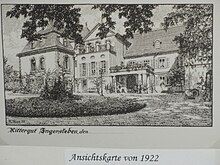Arthur Rose (painter)
Arthur Rose (* July 8, 1891 in Dietendorf near Neudietendorf ; † January 23, 1974 in Erfurt ) was a German painter and graphic artist , as a picture chronicler of the "painter of old Thuringia ".
Live and act
On his father's side, Arthur Rose came from a family that had lived in Apfelstädt since 1430 . His father was the "royal train driver of the Prussian State Railways", which involved frequent moves. So he came to Rodach near Coburg via Suhl , where he attended elementary school from 1898 to 1905. During school he received private drawing lessons. From 1905 to 1909 he was a student in Fritz Lütkemeyer's studio for theater painting and stage equipment in Coburg and received instruction at the technical college. In 1910 Arthur Rose fell ill with polio , which left him confined to bed for months. It was not until 1912 that he had recovered enough to be able to walk again on crutches, but he was unable to walk all his life.
From 1911 to 1917 Rose lived with parents and siblings in Arnstadt , from 1917 in Erfurt, where he married Olga Oxfort in 1918 in the Barefoot Church . The couple moved to Neudietendorf that same year, where their daughter Rosemarie was born in 1919 and Hannelore in 1930. Arthur Rose set up a studio in the attic of his house.
From 1922 to 1924 he attended the art college in Weimar , where he studied with the landscape painter Walther Klemm , among other things . Despite his physical handicap, Rose worked as a painter, draftsman and photographer well into old age and died in Erfurt in 1974. He found his final resting place in the historical cemetery of the Brethren in Neudietendorf.
Rose created watercolors , drawings , etchings and graphics (bookplates, labels for businesses, emergency notes), postcards, book and calendar illustrations. His motifs were historical buildings, but also quiet corners of the old town, villages and landscapes of Central Thuringia. Rose recorded many buildings in great detail that later fell victim to the Second World War and the post-war period, for example the castle in Günthersleben , which was demolished in 1947–1952, and the castle-like "villa" of the manor in Ingersleben, which was removed in 1947 .
As early as 1912, works by the young Rose were exhibited for the first time in Gotha and Franconia , followed by exhibitions in Arnstadt, Weimar, Gotha, Erfurt and Weißensee throughout his career . His works are exhibited in museums, galleries, houses of important personalities, administrations and medical practices. To this day, Rose is regarded as a native painter and “three equals painter”. From 1972 to 1973 he was honored with a special exhibition Arthur Rose - The Painter of Old Arnstadt . Even after Rose's death there were several exhibitions of his works in Neudietendorf, Ingersleben , Arnstadt and Hohenfelden from 1991 to 2010 .
literature
- Horst Benneckenstein: Arthur Rose - Thuringian painter and chronicler. Published by Arnstadt Castle Museum. Arnstadt 2001.
Web links
- Literature by and about Arthur Rose in the catalog of the German National Library
| personal data | |
|---|---|
| SURNAME | Rose, Arthur |
| BRIEF DESCRIPTION | German painter and graphic artist |
| DATE OF BIRTH | July 8, 1891 |
| PLACE OF BIRTH | Dietendorf |
| DATE OF DEATH | 23rd January 1974 |
| Place of death | Erfurt |

